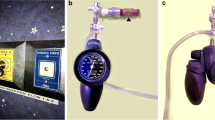Abstract
Background
Intussusception is one of the most common causes of acute abdominal emergency in children. Image-monitored pressure reduction is the first line of treatment.
Objective
We report on a modified technique of air delivery during fluoroscopic-monitored pneumatic intussusception reductions, and compare it with an established technique.
Materials and methods
We modified the Shiels intussusception reduction device so that the air used for intussusception reduction is delivered not by the device’s insufflator bulb, but rather by the hospital medical air supply system, eliminating the need for continuous pumping of the insufflator bulb during the procedure. Subsequently, we retrospectively compared sequential fluoroscopy-monitored pneumatic intussusception reduction procedures performed in patients younger than 18 years using either the standard or modified devices, evaluating technical procedure parameters (i.e. median procedure time length, fluoroscopy time length and radiation dose) and patient outcomes (i.e. number of complete intussusception reductions, number of incomplete intussusception reductions, number of intussusception recurrences within 3 days of the procedure, number of procedures followed by surgery).
Results
We found no statistically significant differences between procedures performed with the standard and modified techniques.
Conclusion
The device modification allows for increased operator comfort. Evaluated procedure parameters and patient outcomes appear similar to those of the standard technique.


Similar content being viewed by others
References
Waseem M, Rosenberg HK (2008) Intussusception. Pediatr Emerg Care 24:793–800
Stein-Wexler R, O'Connor R, Daldrup-Link H et al (2015) Current methods for reducing intussusception: survey results. Pediatr Radiol 45:667–674
Guo JZ, Ma XY, Zhou QH et al (1986) Results of air pressure enema reduction of intussusception: 6,396 cases in 13 years. J Pediatr Surg 21:1201–1203
Crystal P, Hertzanu Y, Farber B et al (2002) Sonographically guided hydrostatic reduction of intussusception in children. J Clin Ultrasound 30:343–348
Gu L, Zhu H, Wang S et al (2000) Sonographic guidance of air enema for intussusception reduction in children. Pediatr Radiol 30:339–342
Shiels WE 2nd, Bisset GS 3rd, Kirks DR et al (1990) Simple device for air reduction of intussusception. Pediatr Radiol 20:472–474
Paterson CA, Langer JC, Somers S et al (1994) Pneumatic reduction of intussusception using carbon dioxide. Pediatr Radiol 24:296–297
Author information
Authors and Affiliations
Corresponding author
Ethics declarations
Conflicts of interest
None
Rights and permissions
About this article
Cite this article
Jindal, G., Graeber, B.L., Staib, L.H. et al. Assessment of a modified technique for air delivery during fluoroscopic-monitored pneumatic intussusception reduction. Pediatr Radiol 47, 1594–1598 (2017). https://doi.org/10.1007/s00247-017-3920-z
Received:
Revised:
Accepted:
Published:
Issue Date:
DOI: https://doi.org/10.1007/s00247-017-3920-z




